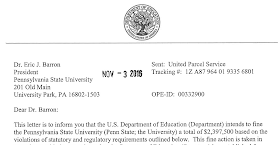(Cornell University, Report of the College of Arts and Sciences Committee on Streamlining Research Administration, 2015)
Existing and new policies run the risk of a hidden cost – increasing the time required by faculty and/or staff for compliance. While this cost may be justified by the risk or benefit underlying the policy, the gradual accretion of these small burdens decreases the productivity of both faculty and staff and that makes it more difficult to pursue the academic mission. Moreover, without examining the time required for compliance, it is impossible to fully understand the cost-benefit of any existing or new policy. (Cornell, Stay Informed)
This is how Cornell University, through the efforts of its faculty and the cooperation of its administrators, has sought to frame the issue of bureaucratic creep that has marked at least one aspect of the transformation of post secondary education as an industry in the 21st century. It is a reminder that administrative creep emerges because of the increasing task for risk management and transparency to outside constituencies and public regulators. It evidences an overlooked manifestation of administrative creep within the risk management university--the rise of responsibilities to feed the administrative machinery with data necessary to fuel the functioning of the administrative apparatus. (The Riskless University and the Bureaucratization of Knowledge: From "Indiana Jones" to Central Planning). At Cornell is is references as "Overzealous Risk Management, which paralyzes research function" (Report, 2015, p. 2).
Cornell has done more than document the way that the burden of a growing
administration with an engorged portfolio has increasingly fallen to
faculty. There is a lesson here for many universities--and not just Research 1
institutions. The most important lesson is one that touches on shared governance in risk management:
These faculty and staff stakeholders should not be called in as advisors in the development of the procedure. Rather, they need to be an integral part of the development process, with the power to prevent the procedure from being implemented until the group as a whole has come to consensus that the proposed procedure is both necessary and as efficient as possible. (Report, 2015, p. 8-9)
This post includes links to the relevant documents
produced at and about the efforts to meet the challenge of shadow work at Cornell.
























